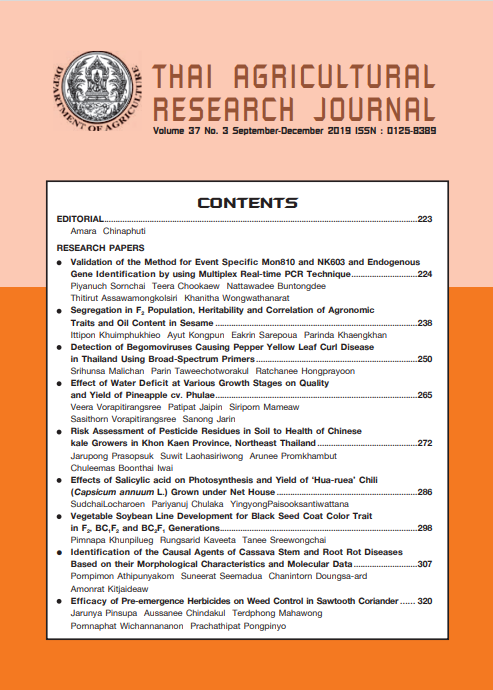Effects of Salicylic acid on Photosynthesis and Yield of ‘Hua-ruea’ Chili (Capsicum annuum L.) Grown under Net House
DOI:
https://doi.org/10.14456/thaidoa-agres.2019.24Keywords:
gas exchange, stomatal conductance, chlorophyll fluorescence, environmental stress, vapor pressure deficit (VPD)Abstract
The main factor of climate inside net house that affects plant growth is high
temperature. High temperature reduces photosynthesis and yield of chili. Exogenous
application of salicylic acid (SA) can reduce plant stress grown under high temperature
condition. The objective of this experiment was to study on physiological changes of chili
grown in net house and to evaluate the effects of SA application on photosynthetic rate and
yield of chili. The experiment was carried out from January to May, 2017. The SA
concentrations of 10-5 or 10-7 M were foliar sprayed on leaves of chili cv. Hua-ruea during
reproductive growth stage, and compared photosynthetic rate and yield with those sprayed
with water (control). Results showed that photosynthesis and total yield of control plants
were lower than SA treated plants when grown under high temperature condition. SA
concentrations of 10-5 or 10-7 M increased stomatal conductance (gs), net photosynthetic
rate (Pn), intercellular CO2 concentration (Ci) and transpiration rate (E). SA treated plants
gave higher total yield and value of Fv/Fm than those of control. In conclusion SA
concentrations of 10-5 or 10-7 M increased the photosynthesis and total yield of chili grown
under high temperature in the net house.
References
กรมอุตุนิยมวิทยา. 2559. สรุปสภาวะอากาศของประเทศไทย พ.ศ.2559. แหล่งที่มา: http://www.tmd.go.th, 17 มิถุนายน 2562.
รุ่งรัตน์ เหลืองนทีเทพ. 2540. เครื่องเทศและสมุนไพร. สำนักพิมพ์โอเดียนสโตร์, กรุงเทพฯ.
ศุภกร ชินวรรโณ, วิริยะ เหลืองอร่าม, เฉลิมรัฐ แสงมณี และ จุฑาทิพย์ ธนกิตติ์เมธาวุฒิ. 2552. การจำลองสภาพภูมิอากาศอนาคตสำหรับ ประเทศไทยและพื้นที่ข้างเคียง. ใน รายงานวิจัยฉบับสมบูรณ์ชุดโครงการการเปลี่ยนแปลงสภาพภูมิอากาศและผลกระทบต่อประเทศ ไทย สำนักงานกองทุนสนับสนุนการวิจัย (สกว.), กรุงเทพฯ.
สำนักยา. 2556. บัญชียาจากสมุนไพร บัญชียาหลักแห่งชาติ. แหล่งที่มา: http://drug.fda.moph.go.th, 30 ตุลาคม 2556.
สำนักส่งเสริมและจัดการสินค้าเกษตร. ข้อมูลการเกษตร. สถานการณ์สินค้าเกษตร. แหล่งที่มา: http://www.agriman.doae.go.th,
17 มิถุนายน 2562
สุทิน หิรัญอ่อน. 2547.สรีรวิทยาการเจริญเติบโตของพริกขี้หนูสายพันธุ์พ่อแม่ (83-168 และพริกช่อมข.) ลูกผสมตรง และลูกผสมสลับ. วิทยานิพนธ์ปริญญาโท. มหาวิทยาลัยเกษตรศาสตร์, กรุงเทพฯ.
สุนทรี ยิ่งชัชวาลย์, คัทลียา ฉัตรเที่ยง, ธาดา ชัยสีหา, จิตรฤทัย ชูมาก, สุทิน หิรัญอ่อน, และภูริพงศ์ ดำรงวุฒิ. 2544. อัตราสังเคราะห์แสง สุทธิ และคายน้ำในรอบวันของใบส้มเขียวหวาน, น. 62-81. ใน รายงานโครงการพัฒนาวิชาการข้อมูลพื้นฐานทางสรีรวิทยาของ ส้มเขียวหวาน. มหาวิทยาลัยเกษตรศาสตร์,นครปฐม.
อภิชาติ วรรณวิจิตร. 2557. โครงการสถานภาพงานวิจัยด้านเทคโนโลยีชีวภาพกับการปรับปรุงระบบการสังเคราะห์แสงภายใต้สภาวะโลกร้อน. แหล่งที่มา: http://dna.kps.ku.ac.th, 30 ธันวาคม 2557.
Bakker, J. C. 1989. The effects of air humidity on growth and fruit production of sweet pepper (Capsicum annuum L.).
J. Hort. Sci. 64: 41–46.
Bhatt, R.M., N.K.S. Rao and N. Anand. 1999. Response of bell pepper (Capsicum annuum L.) to aeradiance photosynthesis, reproductive attributes and yield. Indian Journal of Horticulture 56 (1): 162-166.
Bjorkman, O. and B. Demmig. 1998. Photon yield of O2 evolution and chlorophyll fluorescence characteristics at 77 K among vascular plant of diverse origins. Planta. 170 (4): 489-504.
Bosland, P.W. and E.J. Votava. 2000. Pepper: Vegetable and Spice Capsicums. CABI Publishing, London.
Erickson, A.N. and A.H. Markhart. 2001. Flower production, fruit set, and physiology of bell pepper during elevated temperature and vapor pressure deficit. J. Amer. Soc. Hort. Sci. 126(6):697-702.
Espinosa-Calderon, A., Torres-Pacheco, Padilla-Medina, J.A., Chavaro-Ortiz, R.M., Xoconoste-Cazares, B.,Gomez-Silva, L.,
Ruiz-Medrano, R. and R.G. Guevara-Gonzalez. 2012. Relationship between leaf temperature and photosynthesis carbon in Capsicum annuum L. in controlled climates. Journal of Scientific & Industrial Research 71:528- 533.
Fu, Q.S., Zhao, B., Wang, Y.J., Ren, S. and Y.D. Guo. 2010. Stomatal development and associated photosynthetic performance of capsicum in response to differential light availabilities. Photosynthetica 48(2): 189-198.
Ghai, N., Setia, R.C. and N. Setia. 2002. Effects of paclobutrazol and salicylic acid on chlorophyll content, hill activity and yield components in Brassica napus L. (cv.GSL-1). Phytomorphology 52(1):83-87.
Hayat, S., Masood, A., Yusuf, M., Feriduddin, Q. and A. Ahmad. 2009. Growth of indian mustard (Brassica juncea L.) in response to salicylic acid under high-temperature stress. Braz. J. Plant Physiolo. 21(3):187-195.
Javanmardi, J. and N. Akbari. 2016. Salicylic acid at different plant growth stages affects secondary metabolites and phisico-chemical parameters of greenhouse tomato. Adv. Hort. Sci 30(3): 151-157.
Khan, W., Prithiviraj, B. and D.I. Smith. 2003. Photosynthetic responses of corn and soybean to foliar application of salicylates. J. Plant Physiol 160: 485-492.
Koch, K. 2004. Carbohydrate-modulated gene expression in plants. Annu. Rev. Plant Physiol. 47: 509-540.
Krause, G.H. and E. Weis. 1991. Chlorophyll fluorescence and photosynthesis: The basics. Annu. Rev. Plant. Physiol. Plant. Mol. Biol. 42: 313-349.
Liu, W., Ai, X.Z., Liang, W.J., Wang, H.T., Liu, S.X. and Zheng, N. 2009. Effects of salicylic acid on the leaf photosynthesis and antioxidant enzyme activities of cucumber seedlings under low temperature and light intensity. Chin J Appl Ecol 20:441-445.
Marcelis, L.F.M. and L.R.B. Hofman-eijer. 1997. Effects of seed number on competition and dominance among fruits in Capsicum annuum L. Annals of Botany 79: 687-693.
Mahdavian, K., K.M. Kalantari, M. Ghorbanli and M. Torkzade. 2008. The effects of salicylic acid on pigment contents in ultraviolet radiation stressed pepper plants. Biologia Plantarum 52 (1): 170-172.
Murray, F.W. 1967. On the computation of saturation vapor pressure. Journal of Applied Meteorology and Climatology 6:203-204.
Osari, S., Ruan, Y.G. and R. F. Alisdair. 2014. An update on soruce to sink carbon partitioning in tomato. Frontiers in plant science. doi: 10.3389/fpls. 2014.00516
Pancheva, T.V. and L.P. Popova. 1998. Effect of the salicylic acid on the synthesis of ribulose-1,5-bisphosphate carboxylase/oxygenase in barley leaves. Plant Physiology 152: 381– 386.
Resh, M.H. 1978. Hydroponic Food Production. Woodbridge Press Publishing Company, California.
Shi, Q., Bao, Z., Zhu, Z., Ying, Q. and Q. Qian. 2006. Effects of different treatments of salicylic acid on heat tolerance, chlorophyll fluorescence, and antioxidant enzyme activity in seedlings of Cucumis sativa L. Plant Growth Regulation 48:127–135
Stephen, P.L., X.G. Zhu, S.L. Naidu and D.R. Ort. 2006. Can improvement in photosynthesis increase crop yields?. Plant, Cell and Environment 29: 315-330.
Yildirim, E. and A. Dursun. 2009. Effect of foliar salicylic acid applications on plant growth and yield of tomato under greenhouse conditions. Acta Horticulturae. 807: 395-400.
Downloads
Published
How to Cite
Issue
Section
License
Copyright (c) 2020 Thai Agricultural Research Journal

This work is licensed under a Creative Commons Attribution-NonCommercial-NoDerivatives 4.0 International License.
Thai Agricultural Research Journal



